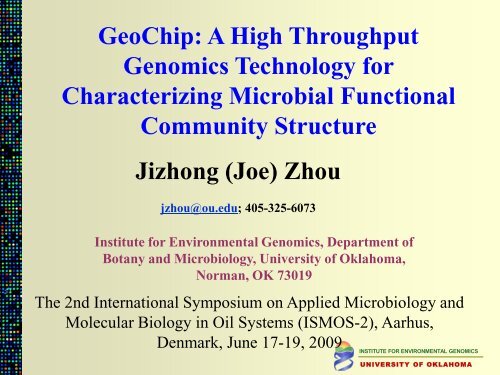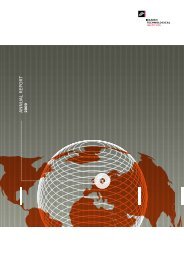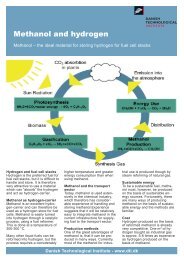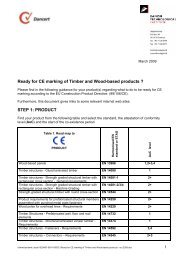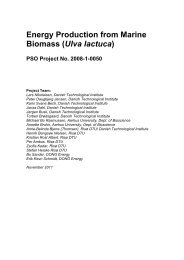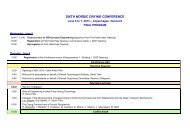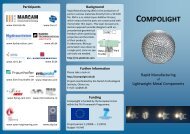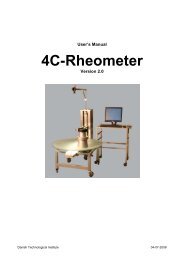Jizhong (Joe) Zhou GeoChip - Danish Technological Institute
Jizhong (Joe) Zhou GeoChip - Danish Technological Institute
Jizhong (Joe) Zhou GeoChip - Danish Technological Institute
You also want an ePaper? Increase the reach of your titles
YUMPU automatically turns print PDFs into web optimized ePapers that Google loves.
<strong>GeoChip</strong>: A High Throughput<br />
Genomics Technology for<br />
Characterizing Microbial Functional<br />
Community Structure<br />
<strong>Jizhong</strong> (<strong>Joe</strong>) <strong>Zhou</strong><br />
jzhou@ou.edu; 405-325-6073<br />
<strong>Institute</strong> for Environmental Genomics, Department of<br />
Botany and Microbiology, University of Oklahoma,<br />
Norman, OK 73019<br />
The 2nd International Symposium on Applied Microbiology and<br />
Molecular Biology in Oil Systems (ISMOS-2), Aarhus,<br />
Denmark, June 17-19, 2009<br />
INSTITUTE FOR ENVIRONMENTAL GENOMICS<br />
UNIVERSITY OF OKLAHOMA
Outline<br />
<strong>GeoChip</strong> development<br />
Challenging<br />
Designing<br />
Performance<br />
<strong>GeoChip</strong> applications<br />
Oil contaminated sites<br />
Ecological Network analysis<br />
Random matrix theory<br />
Microbial community responses to elevated CO2<br />
INSTITUTE FOR ENVIRONMENTAL GENOMICS<br />
UNIVERSITY OF OKLAHOMA
Gene Expression Patterns<br />
Whole Genome<br />
Microarrays<br />
Microbial<br />
functional<br />
Genomics<br />
Community &<br />
Ecosystem<br />
Genomics<br />
Genomic<br />
Technology<br />
Microbial<br />
Ecology &<br />
Extremophiles<br />
Oligonucleotide<br />
Arrays<br />
Functional<br />
Gene<br />
Arrays<br />
Community<br />
Genome Arrays<br />
Microbial Community<br />
Diversity & Mechanisms<br />
Producing Magnetic<br />
Nanoparticles<br />
Uranium Reduction<br />
INSTITUTE FOR ENVIRONMENTAL GENOMICS<br />
UNIVERSITY OF OKLAHOMA<br />
Protein array
High throughput approaches<br />
Open format detection<br />
Could not assure the same genes/proteins/organisms can be compared<br />
across different samples. The results could be expected and thus are<br />
open<br />
High throughput Sequencing<br />
454 sequencing, 250bp, 60-100mb/run<br />
Solexa, SOLiD: 35bp, 1-2 gb/run<br />
Proteomics<br />
Metabolomics<br />
Close format --- Microarrays, EcoPlates<br />
Ensure that the same genes/proteins/organisms can be compared<br />
across different samples. The results can be expected, and thus are<br />
close.<br />
PhyloChip: 16S genes<br />
<strong>GeoChip</strong>: functional genes<br />
INSTITUTE FOR ENVIRONMENTAL GENOMICS<br />
UNIVERSITY OF OKLAHOMA
Comparisons between open<br />
format and close format detection<br />
Open format<br />
Close format<br />
Low<br />
Sensitivity to random<br />
High<br />
sampling errors<br />
Effects by dominant<br />
Yes<br />
No<br />
organisms<br />
Finding new things Yes No<br />
Sensitivity to<br />
contaminated DNAs<br />
Comparison across<br />
samples<br />
Yes<br />
No<br />
Yes<br />
INSTITUTE FOR ENVIRONMENTAL GENOMICS<br />
UNIVERSITY OF OKLAHOMA
<strong>GeoChip</strong> or Functional Gene Arrays<br />
(FGAs)<br />
Microarrays: Glass slides or other<br />
solid surface containing thousands of<br />
genes arrayed by automated equipment.<br />
FGAs contain probes from the genes<br />
involved in various geochemical,<br />
ecological and environmental processes.<br />
C, N, S, P cylcings<br />
Organic contaminant degradation<br />
Metal resistance and reduction<br />
Typical format: 50mer oligonucleotide<br />
arrays<br />
Useful for studying microbial<br />
communities<br />
Functional gene diversity and activity<br />
Limited phylogenetic diversity.<br />
INSTITUTE FOR ENVIRONMENTAL GENOMICS<br />
UNIVERSITY OF OKLAHOMA
Main advantages of <strong>GeoChip</strong><br />
compared to other approaches<br />
(e.g., 16S-based 454 sequencing)<br />
Detecting functions: Geochemical<br />
processes<br />
Higher resolution: Species-strain level<br />
resolution<br />
Quantitative: no PCR is involved<br />
INSTITUTE FOR ENVIRONMENTAL GENOMICS<br />
UNIVERSITY OF OKLAHOMA
Issues related to specificity, sensitivity and quantitation<br />
Specificity, sensitivity, quantitation<br />
Wu et al. 2001; AEM:67: 5780-5790<br />
Rhee et al. 2004, AEM 70:4303-4317<br />
Tiquia et al. 2004. BioTechniques 36, 664-<br />
675<br />
Wu et al. 2004; EST, 38: 6775-6782<br />
He et al, 2007; The ISME J, 1: 67-77<br />
He and <strong>Zhou</strong>, 2008, AEM, 74: 2957–2966<br />
Probe design criteria<br />
He et al. 2005. AEM. 71:3753-3760<br />
Liebich et al. AEM, 72:1688-1691<br />
Deng et al. 2009, BMC Genomics<br />
New probe designing software:<br />
CommOligo<br />
Li et al. 2005. Nucl. Acids Res. 33:6114-<br />
6123<br />
Whole community genome<br />
amplification (WCGA)<br />
Wu et al. 2006. AEM: 72:4931-4941.<br />
Whole community RNA amplification<br />
(WCRA)<br />
Gao et al, 2007, AEM: 73: 563-571.<br />
Review:<br />
Gentry et al. 2006, Microbial Ecology, 52:<br />
159-175.<br />
<br />
<br />
<strong>Zhou</strong> and Thompson, 2002, Curr Opion<br />
Biotech: 13:204-207<br />
<strong>Zhou</strong>, 2003; Curr Opion. Microbiol,<br />
6:288-294<br />
<br />
Applications<br />
He et al, 2007; The ISME J, 1: 67-77 ,<br />
Leigh et al, 2007, The ISME J, 1: 163-179<br />
Yergeau et al, 2007, The ISME J, 1: 134-<br />
148.<br />
<br />
Zhang et al. 2007. FEMS Microbiology<br />
Letters 266: 144-151.<br />
Wu et a., 2008, AEM, 74: 4516-4529<br />
<strong>Zhou</strong> et al. 2008. PNAS, 105:<br />
7768-7773<br />
Wang et al. 2009. PNAS, 106:<br />
4840-4845<br />
Liang et al, 2009. Chemosphere, 75: 193-<br />
199<br />
Liang et al. 2009, Chemosphere, 3: 231-<br />
<br />
<br />
<br />
242<br />
Masson et al. 2009. ISME J., in press<br />
Waldron et al. EST, 2009, in press<br />
Van Nostrand et al. EM, in revision<br />
INSTITUTE FOR ENVIRONMENTAL GENOMICS<br />
UNIVERSITY OF OKLAHOMA
Pioneering advances in microarraybased<br />
technologies to address challenges<br />
in microbial community genomics<br />
Challenges:<br />
Specificity: Environmental sequence divergences.<br />
Sensitivity: Low biomass.<br />
Quantification:<br />
Existence of contaminants: Humic materials, organic<br />
contaminants, metals and radionuclides.<br />
Solutions<br />
Developing different types of microarrays and novel chemistry to<br />
address different levels of specificity.<br />
Developing novel signal amplification strategy to increase<br />
sensitivity<br />
Optimizing microarray protocols for reliable quantification.<br />
INSTITUTE FOR ENVIRONMENTAL GENOMICS<br />
UNIVERSITY OF OKLAHOMA
% overall similarity<br />
hybridization free energy (kcal mol<br />
-1<br />
)<br />
-30<br />
-40<br />
-50<br />
-60<br />
10<br />
100<br />
96<br />
92<br />
88<br />
84<br />
80<br />
76<br />
72<br />
68<br />
64<br />
Empirical criteria for designing<br />
60<br />
10 15 20 25 30 35 40 45 50<br />
12<br />
idententical sequence stretch<br />
between probe and target (bp)<br />
identical sequence stretch between probe and target (bp)<br />
14<br />
16<br />
He et al. 2005. AEM.<br />
71:3753-3760<br />
Liebich et al. AEM,<br />
72:1688-1691<br />
18<br />
20<br />
70<br />
75<br />
80<br />
85<br />
specific probes<br />
90<br />
overall similarity (%)<br />
• Hybridization condition: 50 C, 50%<br />
formamide<br />
• Evaluation of 516 probes with homology<br />
between less than 86% and 100% or a common<br />
identical sequence stretch of at least 16 bases.<br />
• SNR > 2 as positive<br />
Criteria for designing specific probes<br />
• Similarity: 90%<br />
• Stretches: 20 bases<br />
• Free energy: - 35 kcal/mol<br />
• Specific hybridization was also observed for some<br />
probes with less than 98% similarity to the target<br />
sequences, suggesting that strain level of resolution<br />
could be possibly achieved with some 50mer probes<br />
INSTITUTE FOR ENVIRONMENTAL GENOMICS<br />
under the hybridization conditions examined.<br />
UNIVERSITY OF OKLAHOMA
Specificity of 50 mer microarrays<br />
Specific hybridization was obtained with probes 85% similarity<br />
4 5<br />
• 5 nirS genes were mixed<br />
together<br />
1<br />
• Only corresponding genes<br />
were hybridized<br />
2<br />
3<br />
nir K<br />
• 6 types of genes were<br />
mixed together<br />
• Only corresponding genes<br />
were hybridized<br />
nif H<br />
amo<br />
nir S<br />
A<br />
pmo A<br />
dsr AB<br />
INSTITUTE FOR ENVIRONMENTAL GENOMICS<br />
UNIVERSITY OF OKLAHOMA
Sensitivity<br />
Genomic DNA<br />
Cells<br />
1<br />
2<br />
3<br />
4<br />
5<br />
6<br />
7<br />
8<br />
500 ng gDNA 50 ng<br />
Detection limit<br />
• 50 ng pure DNA in the presence of<br />
non-target templates<br />
• 10 7 cells<br />
25 ng 1.610 9 1.310 7 3.010 6<br />
Rhee et al. 2004, AEM 70:4303-4317<br />
Tiquia et al. 2004. BioTechniques 36,<br />
664-675<br />
INSTITUTE FOR ENVIRONMENTAL GENOMICS<br />
UNIVERSITY OF OKLAHOMA
Quantification and validation<br />
Microarray hybridization<br />
Real-PCR<br />
Log Signal Ratio (Log R)<br />
Log Signal Ratio (Log R)<br />
0.0<br />
-0.5<br />
-1.0<br />
-1.5<br />
r 2 = 0.98<br />
0.5 1.6 10 9<br />
8.0 10 8<br />
2.0 10 8 4.0 10 9<br />
1.0 10 7<br />
5.0 10 7<br />
2.5 10 7<br />
3.0 10 6 1.3 10 7<br />
6.0 10 6<br />
Log Value<br />
12<br />
10<br />
8<br />
6<br />
4<br />
2<br />
0<br />
-2<br />
-4<br />
r=0.86<br />
Real Time PCR (Log Copy Number)<br />
Microarray Hybridization (Log SNR)<br />
1: gi4704462-TFD<br />
2: gi4704463-TFD-Microcosm<br />
3: gi4704464-TFD-Enrichment<br />
4: gi4704463-TFD<br />
5: gi4704464-TFD-Microcosm<br />
6: gi4704465-TFD-Enrichment<br />
7: gi2828015-TFD<br />
8: gi2828016-TFD-Microcosm<br />
9: gi2828017-TFD-Enrichment<br />
10: gi2828018-TFD<br />
11: gi2828019-TFD-Microcosm<br />
12: gi2828020<br />
6 7 8 9 10<br />
Log (Cell Number (Log[N])<br />
0 2 4 6 8 10 12 14<br />
Genes<br />
Quantification<br />
• Good linear relationship<br />
• Quantitative<br />
• Microarray result is<br />
consistent with realtime<br />
PCR<br />
INSTITUTE FOR ENVIRONMENTAL GENOMICS<br />
UNIVERSITY OF OKLAHOMA
Whole community genome<br />
amplification (WCGA) approach for<br />
increasing hybridization sensitivity<br />
10fg<br />
M A1 B1 A2 B2 A3 B3 A4 B4 A5 B5 A6 B6 A7 B7 A8 B8 M<br />
Yields (g)<br />
14 Modified buffer<br />
Commercial buffer<br />
12<br />
10<br />
8<br />
6<br />
4<br />
2<br />
0<br />
100 10<br />
Template Concentrations (fg)<br />
As low as 10fg (2 cells)<br />
can be detected<br />
2-5 fold increase with<br />
modified buffer<br />
INSTITUTE FOR ENVIRONMENTAL GENOMICS<br />
Wu et al. 2006. AEM: 72:4931-4941, top 20 most requested UNIVERSITY paper OF OKLAHOMA in AEM.
Quantification after amplification<br />
with environmental sample<br />
Log Signal Intensity<br />
4.4<br />
4.0<br />
3.6<br />
3.2<br />
2.8<br />
Gene 7363464: r2=0.96<br />
Gene 10441633: r2=0.96<br />
Gene 3452465: r2=0.99<br />
Gene 11967269: r2=0.96<br />
Gene 9651045: r2=0.98<br />
2.4<br />
-2 -1 0 1 2 3<br />
Log DNA Template (ng)<br />
• All genes detected showed significant linear relationships<br />
within the template range from 0.01 ng to 250 ng (r²=0.96-<br />
0.98).<br />
• Only 5 genes are shown here.<br />
INSTITUTE FOR ENVIRONMENTAL GENOMICS<br />
UNIVERSITY OF OKLAHOMA
microgram<br />
Procaryotic mRNA amplification<br />
Template<br />
1 mg, 0.5mg, 0.1mg, 0.01mg<br />
5’<br />
5’<br />
RNA<br />
T7<br />
RNA<br />
T4 gene 32 protein<br />
Spermidine<br />
Linear acryl amide<br />
SSB, RecA<br />
In Vitro Transcription<br />
T7 RNA polymerase<br />
T7- random primer<br />
Reverse transcription<br />
2nd strand synthesis<br />
DNA polymerase, RNaseH<br />
DNA Ligase<br />
T<br />
7<br />
T4 DNA polymerase<br />
T<br />
7<br />
140.0<br />
120.0<br />
100.0<br />
80.0<br />
60.0<br />
40.0<br />
20.0<br />
0.0<br />
aRNA amplification<br />
119<br />
57<br />
18.0<br />
0.2<br />
1 2 3 4<br />
10ng<br />
50ng<br />
100ng<br />
primer only<br />
template<br />
2nd round amplification<br />
Gao et al, 2007,<br />
AEM: 73: 563-571.<br />
T7N6:<br />
T7N6S:<br />
T7T7N6S:<br />
5'AAACGACGGCCAGTGAATTGTAATACGACTCACTATAGGCGCNNNNN[N-Q]<br />
5'AATTGTAATACGACTCACTATAGGGNNNNN[N-Q]<br />
5'AATTGTAATACGACTCACTATAGGGTTAACATTATGCTGAGTGATATCCCNNNNN[N-Q]<br />
INSTITUTE FOR ENVIRONMENTAL GENOMICS<br />
UNIVERSITY OF OKLAHOMA
<strong>GeoChip</strong> 2.0: A high throughput tool for<br />
linking community structure to functions<br />
He, Z, TJ Gentry, CW Schadt, L Wu, J Liebich, SC Chong,<br />
Z Huang, W Wu, B Gu, P Jardine, C Criddle, and J.<br />
<strong>Zhou</strong>. 2007. <strong>GeoChip</strong>: a comprehensive microarray for<br />
investigating biogeochemical, ecological and<br />
environmental processes. The ISME J. 1: 67-77.<br />
Highlighted by:<br />
• A press release by Nature Press Office<br />
•Reported by many Newspapers<br />
• National Ecology Observatory Networks (NEON),<br />
Roadmap<br />
• National Academy of Sciences, Metagenomics report<br />
INSTITUTE FOR ENVIRONMENTAL GENOMICS<br />
UNIVERSITY OF OKLAHOMA
Summary of <strong>GeoChip</strong> 3.0 probe and sequence<br />
information by functional gene category<br />
Functional process<br />
No. of gene<br />
categories<br />
No. sequences<br />
retrieved<br />
No. of probes<br />
designed<br />
No. CDS<br />
covered<br />
Antibiotic resistance 11 7571 1710 2904<br />
Carbon degradation 31 9839 2720 4737<br />
Carbon fixation 5 3378 898 1806<br />
Methane metabolism 3 4182 254 434<br />
Nitrogen cycling 13 27162 3561 6892<br />
Phosphorus utilization 3 1441 599 1212<br />
Sulfur cycling 3 4296 1328 1773<br />
Metal remediation 41 16825 4917 10458<br />
Contaminant degradation 190 31236 8815 16948<br />
Energy process 2 901 413 449<br />
Others (e.g., GyrB) 3 9359 1860 3897<br />
Total 305 116,190 27,075 51,510<br />
• > 300 functional gene categories<br />
INSTITUTE FOR ENVIRONMENTAL GENOMICS<br />
• Universal standards to allow data comparison across different experiments & times<br />
UNIVERSITY OF OKLAHOMA
Carbon degradation<br />
Gene/category Unique probe Group probe Total probe Total covered CDS<br />
Carbon degradation<br />
acetylglucosaminidase 32 75 107 214<br />
amyA 61 170 231 467<br />
amyX 0 5 5 12<br />
apu 4 2 6 8<br />
ara 21 65 86 174<br />
ara_fungi 23 10 33 50<br />
cda 11 6 17 25<br />
cellobiase 36 41 77 145<br />
endochitinase 199 168 367 606<br />
endoglucanase 64 24 88 109<br />
exochitinase 15 16 31 63<br />
exoglucanase 54 9 63 83<br />
glucoamylase 23 35 58 111<br />
glx 17 4 21 33<br />
isopullulanase 0 1 1 2<br />
lip 25 4 29 39<br />
mannanase 20 9 29 45<br />
mnp 17 2 19 22<br />
nplT 4 16 20 39<br />
pectinase 27 2 29 33<br />
phenol_oxidase 126 81 207 272<br />
pulA 21 88 109 231<br />
xylA 18 72 90 188<br />
xylanase 60 67 127 221<br />
Subtotal 878 972 1850 3192<br />
INSTITUTE FOR ENVIRONMENTAL GENOMICS<br />
UNIVERSITY OF OKLAHOMA
Carbon fixation and methane metabolism<br />
Gene/category Unique probe Group probe Total probe Total covered CDS<br />
Carbon fixation<br />
aclB 20 13 33 53<br />
CODH 13 63 76 138<br />
FTHFS 68 126 194 323<br />
pcc 8 249 257 585<br />
rubisco 139 146 285 515<br />
Subtotal 248 597 845 1614<br />
Methane metabolism<br />
mcrA 104 106 210 392<br />
mmoX 22 22 44 90<br />
pmoA 85 39 124 270<br />
Subtotal 211 167 378 752<br />
INSTITUTE FOR ENVIRONMENTAL GENOMICS<br />
UNIVERSITY OF OKLAHOMA
Nitrogen cycling<br />
Gene/category Unique probe Group probe Total probe Total covered CDS<br />
Nitrogen cycling<br />
amoA 100 95 195 528<br />
gdh 26 19 45 94<br />
hao 2 4 6 18<br />
napA 11 22 33 83<br />
narG 289 160 449 656<br />
nasA 67 86 153 259<br />
nifH 885 333 1218 2467<br />
nirK 255 143 398 1005<br />
nirS 351 155 506 923<br />
norB 55 25 80 102<br />
nosZ 191 119 310 596<br />
ureC 57 218 275 603<br />
Subtotal 2289 1379 3668 7334<br />
INSTITUTE FOR ENVIRONMENTAL GENOMICS<br />
UNIVERSITY OF OKLAHOMA
Phosphorus utilization and sulphur cycling<br />
Gene/category Unique probe Group probe Total probe Total covered CDS<br />
Phosphorus<br />
ppk 47 67 114 237<br />
ppx 44 296 340 832<br />
Subtotal 91 363 454 1069<br />
Sulphur<br />
dsrA 595 155 750 954<br />
dsrB 371 131 502 685<br />
sox 47 52 99 161<br />
Subtotal 1013 338 1351 1800<br />
INSTITUTE FOR ENVIRONMENTAL GENOMICS<br />
UNIVERSITY OF OKLAHOMA
Metal reduction and resistance<br />
Gene/category Total probe Total covered CDS<br />
Metal reduction and resistance<br />
Arsenic resistance 396 803<br />
Cadmium resistance 1254 2808<br />
Chromium resistance 543 1292<br />
Mercury resistance/reduction 292 594<br />
Nickel resistance 42 88<br />
Zinc resistance 1044 2197<br />
Other metals and metalloids 1803 4135<br />
Other metal reduction 413 449<br />
Subtotal 5,787 12,366<br />
INSTITUTE FOR ENVIRONMENTAL GENOMICS<br />
UNIVERSITY OF OKLAHOMA
Organic contaminant degradation<br />
Gene/category Total probe Total covered CDS<br />
Contaminant degradation<br />
BTEX and related aromatics 423 3084<br />
Chloronated aromatics 250 473<br />
Nitroaromatics 122 489<br />
Heterocyclic aromatics 38 66<br />
Hydrocarbons (e.g., PAHs) 179 2089<br />
Chloronated solvents 180 360<br />
Pesticides 1258 3083<br />
Other chemicals and by-products 3936 7855<br />
Subtotal 6,386 17,499<br />
INSTITUTE FOR ENVIRONMENTAL GENOMICS<br />
UNIVERSITY OF OKLAHOMA
Energy-related metabolism processes<br />
Gene/category Total probe Total covered CDS<br />
Energy-related metabolism processes<br />
Cytochromes 365 365<br />
Hydrogenase 48 85<br />
Subtotal 413 450<br />
INSTITUTE FOR ENVIRONMENTAL GENOMICS<br />
UNIVERSITY OF OKLAHOMA
Examples of most recent applications<br />
Groundwaters<br />
Monitoring bioremediation processes: Ur, Cr<br />
Impacts of contaminants on microbial communities<br />
Soils<br />
Grass land soils: effects of plant diversity and climate changes on soil<br />
communities<br />
Forest soil: spatial scaling<br />
Agricultural soils: tillage, no tillage<br />
Oil-contaminated soils<br />
Aquatic environments<br />
Hydrothermal vents<br />
Marine sediments<br />
River sediments<br />
Bioreactors<br />
Wastewater treatments<br />
Biohydrogen<br />
Microbial fuel cell<br />
INSTITUTE FOR ENVIRONMENTAL GENOMICS<br />
Bioleaching<br />
UNIVERSITY OF OKLAHOMA
Overview of Microarray<br />
Analysis<br />
<br />
<br />
<br />
<br />
<br />
<br />
DNA extraction from environmental<br />
samples, multiple samples, times<br />
Whole Community Rolling Circle<br />
Amplification (1-100ng DNA)<br />
Label DNA with Cy5<br />
Hybridization to <strong>GeoChip</strong> at 42, 45 or 50C<br />
with 50% formamide<br />
Data processing with automatic pipeline<br />
Statistical analysis<br />
<br />
Data interpretation<br />
INSTITUTE FOR ENVIRONMENTAL GENOMICS<br />
UNIVERSITY OF OKLAHOMA
Microbial communities in oil fields<br />
Samples were clustered together in terms of the geographical<br />
locations based on GeChip data.<br />
INSTITUTE FOR ENVIRONMENTAL GENOMICS<br />
UNIVERSITY OF OKLAHOMA
DGGE Analysis<br />
Distance (Objective Function)<br />
1.8E-01 7.7E-01 1.4E+00 1.9E+00 2.5E+00<br />
Information Remaining (%)<br />
100 75 50 25 0<br />
DQ-U<br />
JH-U<br />
JH-C<br />
DQ-C<br />
YM-U<br />
YM-C<br />
CQ-U<br />
CQ-C<br />
SL-U<br />
SL-C<br />
Similarly, samples were clustered together in terms of the<br />
geographical locations based on DGGE data..<br />
INSTITUTE FOR ENVIRONMENTAL GENOMICS<br />
UNIVERSITY OF OKLAHOMA
Partial CCA Analysis<br />
(a) Outline (b) DGGE (c) <strong>GeoChip</strong><br />
<br />
<br />
<br />
More variations are explained based on <strong>GeoChip</strong> data than DDGE data<br />
Environmental factors play bigger roles in impacting community structure<br />
than other factors, e.g. distances, and oil contamination.<br />
Oil contamination alone explained about 12% difference.<br />
INSTITUTE FOR ENVIRONMENTAL GENOMICS<br />
UNIVERSITY OF OKLAHOMA
Funding<br />
• Department of Energy<br />
– Genomics:GTL Program<br />
– Microbial Genome Program<br />
– ERSP Program<br />
– Ocean Margin Program<br />
– Carbon cycling programs<br />
• USDA<br />
NSF-USDA Microbial Observatories<br />
• OCAST: Oklahoma Center for the<br />
Advancement of Science and Technology<br />
• Oklahoma Bioenergy Center<br />
INSTITUTE FOR ENVIRONMENTAL GENOMICS<br />
UNIVERSITY OF OKLAHOMA
OU<br />
Zhili He<br />
Liyou Wu<br />
Meiying Xu<br />
Ye Deng<br />
Joy Van Nostrand<br />
Sanghoon Kang<br />
Qichao Tu<br />
Zhenmei Xu<br />
Texas A&M<br />
Terry Gentry<br />
ORNL<br />
Chris Schadt<br />
Acknowledgement<br />
Michigan State University<br />
James M. Tiedje<br />
Jim Cole<br />
Qiong Wang<br />
LBL<br />
Terry Hazen<br />
Stanford Univ<br />
Craig Criddle<br />
Weimin Wu<br />
Univ of Minnesota<br />
Peter Reich<br />
Sarah Hobbie<br />
INSTITUTE FOR ENVIRONMENTAL GENOMICS<br />
UNIVERSITY OF OKLAHOMA
Issues related to specificity, sensitivity and quantitation<br />
Specificity, sensitivity, quantitation<br />
Wu et al. 2001; AEM:67: 5780-5790<br />
Rhee et al. 2004, AEM 70:4303-4317<br />
Tiquia et al. 2004. BioTechniques 36, 664-<br />
675<br />
Wu et al. 2004; EST, 38: 6775-6782<br />
He et al, 2007; The ISME J, 1: 67-77<br />
He and <strong>Zhou</strong>, 2008, AEM, 74: 2957–2966<br />
Probe design criteria<br />
He et al. 2005. AEM. 71:3753-3760<br />
Liebich et al. AEM, 72:1688-1691<br />
Deng et al. 2009, BMC Genomics<br />
New probe designing software:<br />
CommOligo<br />
Li et al. 2005. Nucl. Acids Res. 33:6114-<br />
6123<br />
Whole community genome<br />
amplification (WCGA)<br />
Wu et al. 2006. AEM: 72:4931-4941.<br />
Whole community RNA amplification<br />
(WCRA)<br />
Gao et al, 2007, AEM: 73: 563-571.<br />
Review:<br />
Gentry et al. 2006, Microbial Ecology, 52:<br />
159-175.<br />
<br />
<br />
<strong>Zhou</strong> and Thompson, 2002, Curr Opion<br />
Biotech: 13:204-207<br />
<strong>Zhou</strong>, 2003; Curr Opion. Microbiol,<br />
6:288-294<br />
<br />
Applications<br />
He et al, 2007; The ISME J, 1: 67-77 ,<br />
Leigh et al, 2007, The ISME J, 1: 163-179<br />
Yergeau et al, 2007, The ISME J, 1: 134-<br />
148.<br />
<br />
Zhang et al. 2007. FEMS Microbiology<br />
Letters 266: 144-151.<br />
Wu et a., 2008, AEM, 74: 4516-4529<br />
<strong>Zhou</strong> et al. 2008. PNAS, 105:<br />
7768-7773<br />
Wang et al. 2009. PNAS, 106:<br />
4840-4845<br />
Liang et al, 2009. Chemosphere, 75: 193-<br />
199<br />
Liang et al. 2009, Chemosphere, 3: 231-<br />
<br />
<br />
<br />
242<br />
Masson et al. 2009. ISME J., in press<br />
Waldron et al. EST, 2009, in press<br />
Van Nostrand et al. EM, in revision<br />
INSTITUTE FOR ENVIRONMENTAL GENOMICS<br />
UNIVERSITY OF OKLAHOMA


